Class 185
On this page
Specification table & more images at bottom of page
Est. reading time:
Page Settings
Font:
Font Weight:
Text Size:
Width:
Create an account for enhanced personalisation!
Search Wiki
The Class 185 Desiro is a type of diesel-hydraulic multiple-unit (DHMU) built by Siemens Transportation Systems in Germany for TransPennine Express.
A £260 million order for 51 three-car trains and associated maintenance depots was placed in 2003, and deliveries took place between 2006 and 2007.
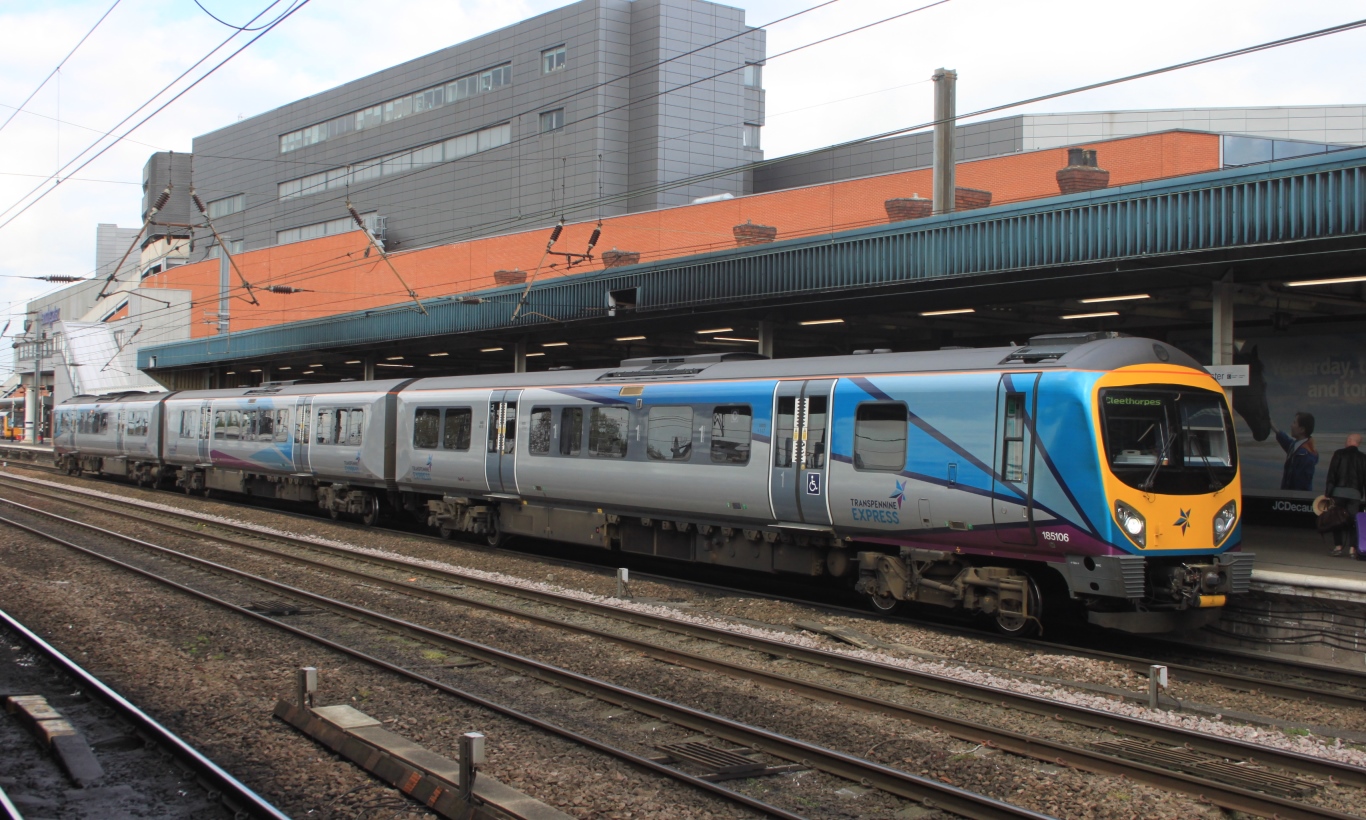
TransPennine Express Class 185 at Doncaster in 2017.
Background & History
In 2003, First TransPennine Express (FTPE), a consortium of FirstGroup and Keolis, was awarded the TransPennine Express (TPE) franchise. One obligation under the franchise agreement was to introduce a new fleet of diesel multiple units, capable of operating at speeds up to 100ph. Also specified was air conditioning, two toilets per vehicle with one suitable for reduced-mobility passengers, gangways between individual carriages, luggage and bicycle storage space, passenger CCTV, provision for wheelchair passengers, and First Class seating. Additionally, the train's acceleration was to be an improvement on the Class 158, and comparable to the Class 180. The agreement specified 168 carriages, with an initial option to reduce the carriage order by 18.
The franchise agreement also required the construction of two depots for the new rolling stock; the main depot was to be at Manchester, with a depot for stabling and maintenance at York. In addition, a depot at Cleethorpes was to be upgraded with refuelling and controlled emission toilet servicing facilities, and a train electric auxiliary supply.
Advertisement
By August 2003, Siemens had been named as the preferred bidder for the trains. A contract for supply and maintenance of 56 trains was signed in September 2003.
The trains were built at Siemens' plant in Uerdingen in Krefeld; the first unit began test trials at the Wildenrath test circuit in July 2005. An official launch took place at Wildenrath on 24 November 2005.
Construction of the Ardwick train depot began March 2005 and was completed in 2006. Work started on the new Leeman Road depot in York in December 2005; opening followed in May 2007. In 2006, FTPE acquired two static simulators for driver training from Corys TESS.
All 51 trains were in service by January 2007. The trains replaced two and three-car Class 158 and Class 175 units.

Class 185 at York in First TransPennine Express Dynamic Lines livery
Design & Technical Details
Each vehicle carries its own powertrain, driving both axles on one of the vehicle's bogies via cardan shafts. Each powertrain consists of a 561 kW (752 hp) Cummins QSK19 turbo-diesel engine driving a Voith T 312 bre three-speed hydrokinetic transmission, which in turn drives the axles via Voith SK-485 and KE-485 final drives. The other bogie on each vehicle is unpowered. The engine and torque converter were frame-mounted underfloor and suspended from the car body by flexible mounts. A third underfloor module contains cooling systems and an electrical generator. The transmission includes an integrated hydraulic retarder. Cooling fans and the electrical generator are powered via a hydrostatic drive. The electrical generator provides a 400 V 50 Hz three phase electrical supply for the train, which is transformed or rectified to a 230 V 50 Hz single phase supply, a 110 V DC auxiliary supply, and a 24 V DC battery supply. Connections bridge the main 400 V AC and 110 V DC supplies across the cars of each train set. Component suppliers included Dellner (couplings), ZF (dampers), SKF (bearings), and Westinghouse Brakes (now Knorr-Bremse, braking systems).
The bogies are derivatives of Siemens' SF5000 type, and were manufactured in Graz, Austria. The design has an distance between each axle of 2.600m, with radial-arm primary suspension utilising steel coil springs with rubber elements; the secondary suspension is an air spring design supporting a bolster. Motor bogies have traction forces transmitted from bogie to frame via rods from a centre pivot. Mechanical brakes are wheel mounted discs. The Class 185 is heavier and has a stiffer suspension than the Class 158 it replaced on some routes. On some routes – including the Hope Valley Line, York to Scarborough Line, Hull to Selby Line, and between Northallerton and Middlesbrough the Class 185 units were not permitted to operate at the same speeds as Sprinter-type DMUs; however the higher acceleration of the Class 185 units could be used to partially offset the lower speed restriction. Between Northallerton and Middlesbrough, Class 185s and Sprinters now use the same speed limits.
Advertisement
As delivered each train consisted of three cars; one end car (DMOSB) had 64 standard class seats in a 2+2 arrangement with a mixture of facing seats with tables and airline style arrangements, as well as luggage and bicycle facilities; the middle car (MOSL) had 72 standard class seats also in a mixture of arrangements in 2+2 formation, and incorporated a standard toilet; the other end car (DMOCLW) had a further 18 standard class seats, and 15 2+1 arrangement first class seats, plus a wheelchair space, and a reduced mobility access toilet. Toilets were supplied by Driessen, seats by Grammer and Fainsa, and air conditioning by Air International Transit.
Eco-Mode
The trains were designed for the steep hills encountered on the TransPennine routes; as a result the units had a high installed power, unnecessary for most of the train's route sections, leading to low fuel efficiency relative to other DMUs. In mid-2007, Siemens and First TransPennine Express began a programme, named 'Eco-Mode', to improve the efficiency of the fleet. The project involved generating driver information giving route advice allowing more efficient driving, including information on when it was feasible to shut down a diesel engine, leaving the train 'cruising' on two of the three engines. Additionally fuel consumption was reduced by performing shunting using only one engine, and automating complete engine shutdown at depots. Initial changes in working practice resulted in a 7% fuel saving. Furthermore, as the engines are idling less and thus operating less (engine hours reduced by two hours a day per train), their service life may be extended by 15%.
Operations
TransPennine Express
The 51 three-car Class 185 units, together with nine two-car Class 170 units, replaced the Class 158 (North and South TransPennine Express routes), Class 175 (routes between Manchester Airport and Blackpool / Cumbria) and Class 220 / Class 221 Voyager trains (operated by Virgin CrossCountry on routes between Manchester and Edinburgh / Glasgow).
To free up stock for services between Manchester Airport and destinations in Scotland when First TransPennine Express first took over these routes, the frequency of the Manchester Airport to Windermere route was reduced from December 2007.
In 2014, the introduction of ten electric Class 350 units on services between Manchester and Scotland allowed the displacement of Class 170 and some Class 185 units to provide additional capacity on FTPE's network. Two (originally four) Class 185 units were loaned to Arriva Rail North from April 2016 until May 2019.
Following the introduction of the new Nova fleet in 2019 and 2020, it was originally planned and expected that 22 Class 185 units would return to Eversholt Rail Group. However, in September 2019, TransPennine Express announced that it would only be returning 15, with the remaining units being required to operate diversionary services during upgrades to the TransPennine route. In June 2020, TransPennine Express confirmed that the return of 15 sets would be postponed until further notice.
Overcrowding & Passenger Feedback
In 2007, Passenger Focus published a user survey on the Class 185. Satisfaction ratings of around 80% were given for many standard aspects of a train journey, such as availability of seats, seat comfort, ease of egression, and cleanliness. Passengers gave satisfaction ratings of around only 70% on standing space availability. Lower averaged satisfaction ratings (~50%) were given for wheelchair space, bicycle space, and for the inability to shield the sun, as well as overall design, and position and number of bins. Frequent travellers had a low level of satisfaction with toilet cleanliness. The report concluded that overall users liked the new trains, but identified issues relating to peak crowding, particularly on evening peaks.
Advertisement
By 2007, increased use of some of the First TransPennine Express services (Sheffield, Manchester and Leeds) caused the operator to start lobbying the SRA for a fourth car to the three-car sets to increase capacity; however, the service overall was subsidised, presenting a cost barrier to further rolling stock leasing. By 2008, many of the peak-time trains operated by Class 185s on First TransPennine Express services were suffering chronic overcrowding.
Refurbishment
In June 2017, TransPennine Express began refurbishing Class 185s as part of its franchise commitments. The first unit was completed in July 2017, entering service within the same week. The refurbished trains include new seats throughout the train (including leather in First Class), standard plug and USB sockets at every pair of seats, new decor, refitted toilets, and LED lighting throughout. The refurbishment was completed in 2018.
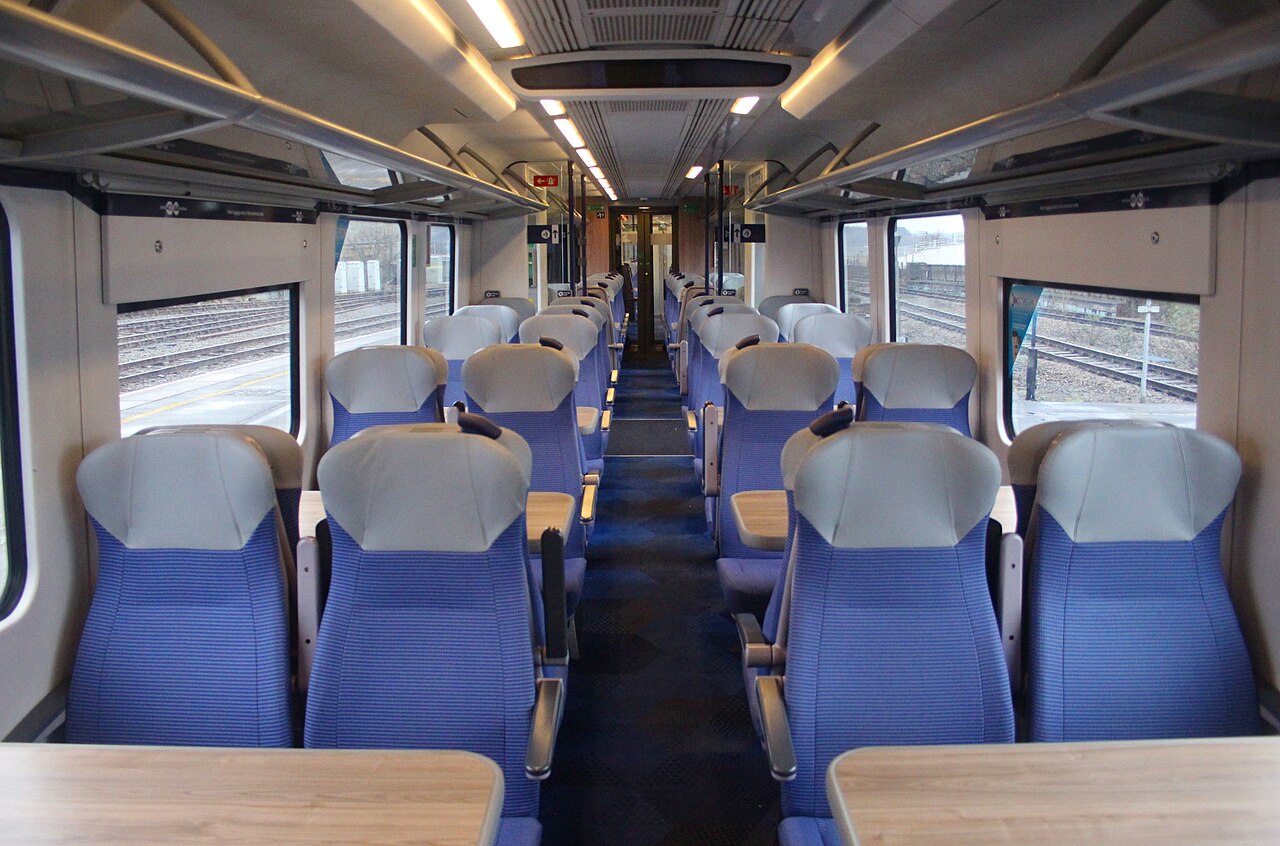
Refurbished standard-class interior.
Class 185
| Type | Diesel Multiple Unit |
|---|---|
| In service | March 2006 - present |
| Family | Desiro |
| Operators | TransPennine Express |
| Manufacturer | Siemens Transportation Systems |
| Constructed | 2005-2006 |
| Built at | Krefeld, Germany |
Technical Specifications
| Car body | Aluminium |
|---|---|
| Width | 2.673m |
| Height | 3.710m |
| Doors | Double-leaf sliding plug (2 per side per car) |
| Max Speed | 100mph |
| Acceleration | 0.49 m/s2 (1.6 ft/s2) |
| Safety Systems |
AWS TPWS |
| Coupling System | Dellner 12 |
| Braking Systems | Electro-pneumatic (disc) plus hydraulic retarder |
| Engine Type | Inline-6 turbo-diesel |
| Power Output | 1,683 kW (2,257 hp) at 2100 rpm (561 kW (752 hp) per engine) |
| Transmission | Voith T 312 bre (hydrokinetic, one per car) |
| Track Gauge | 1,435 mm (4 ft 8 1⁄2 in) standard gauge |
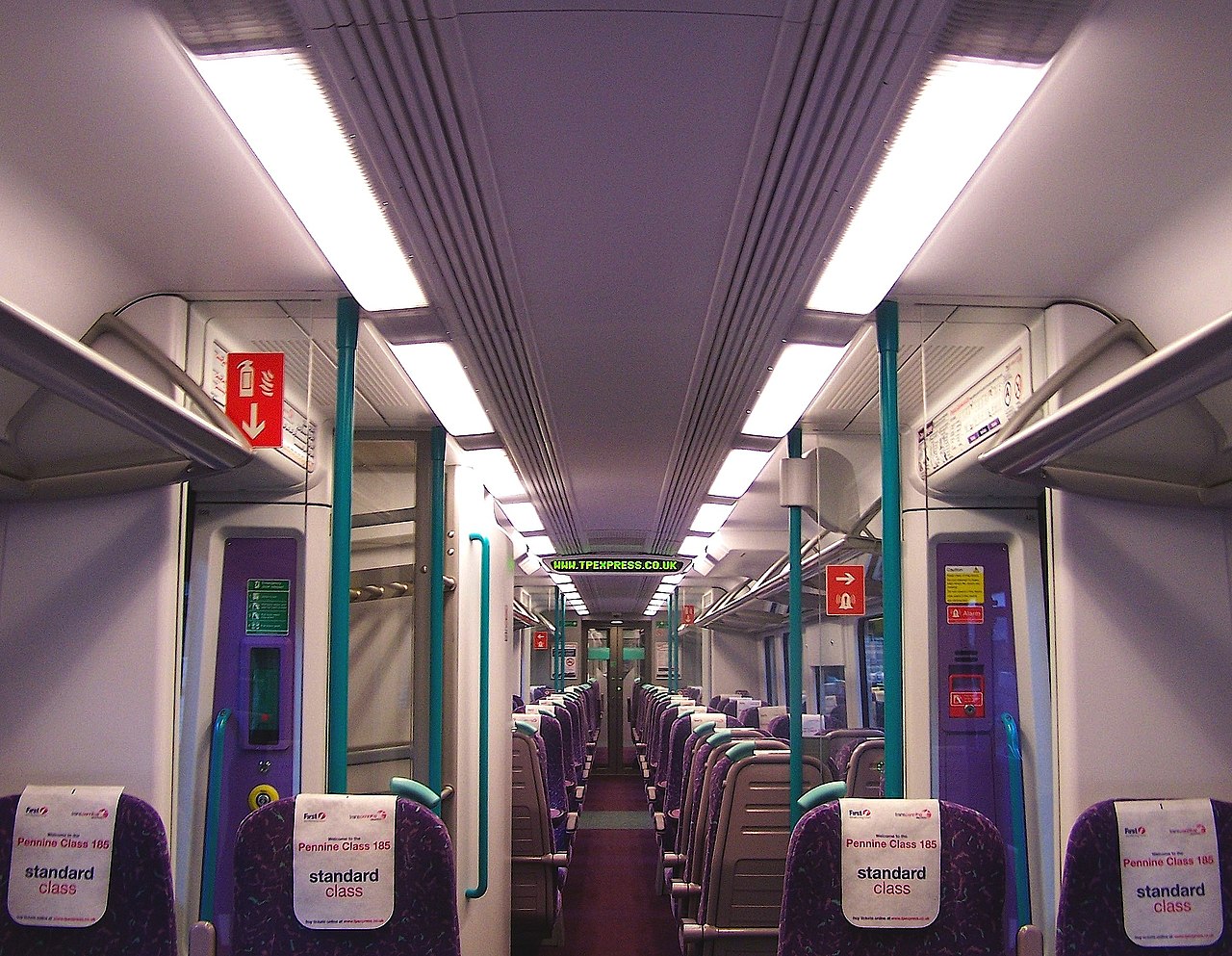
Original Standard Class interior
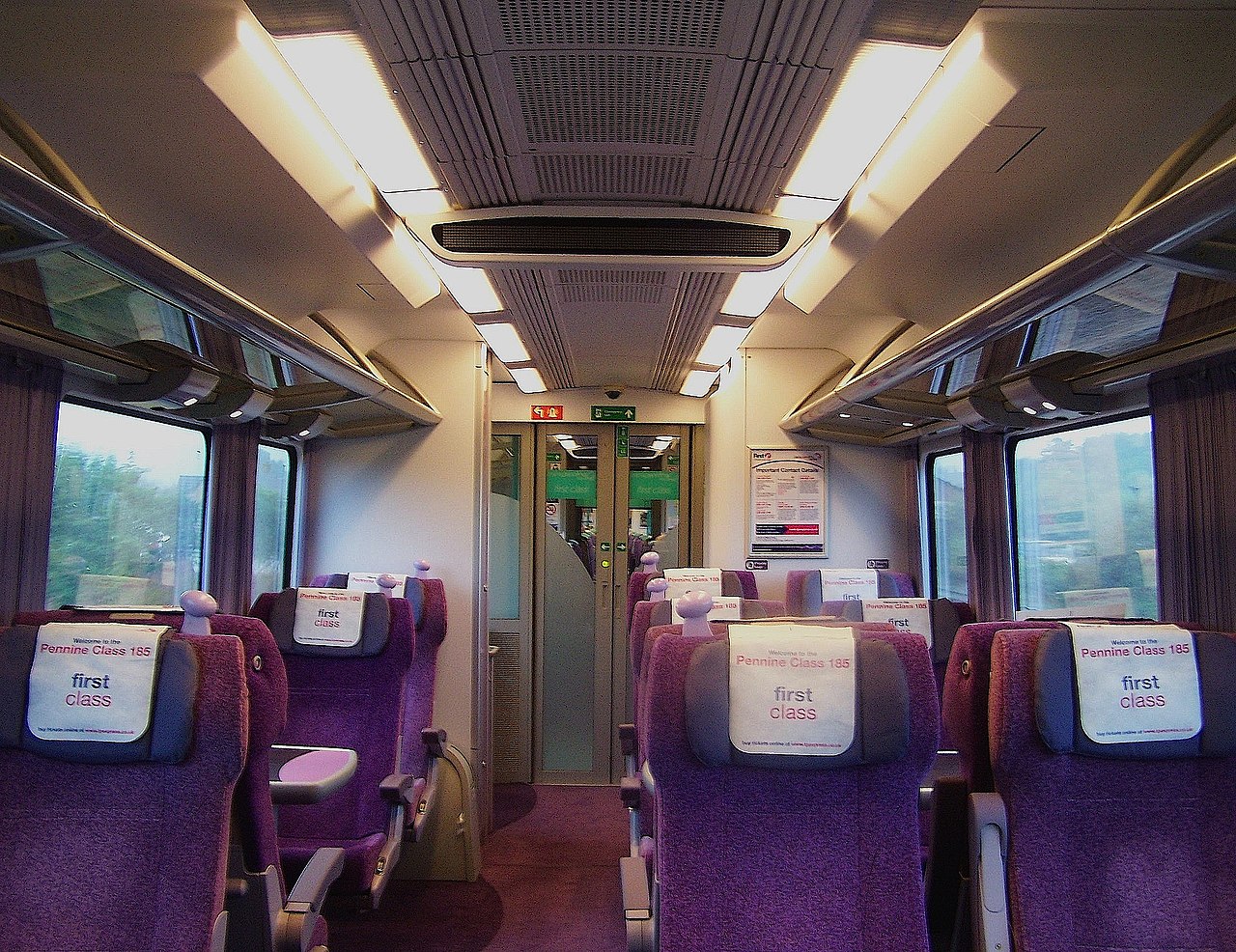
Original First Class interior
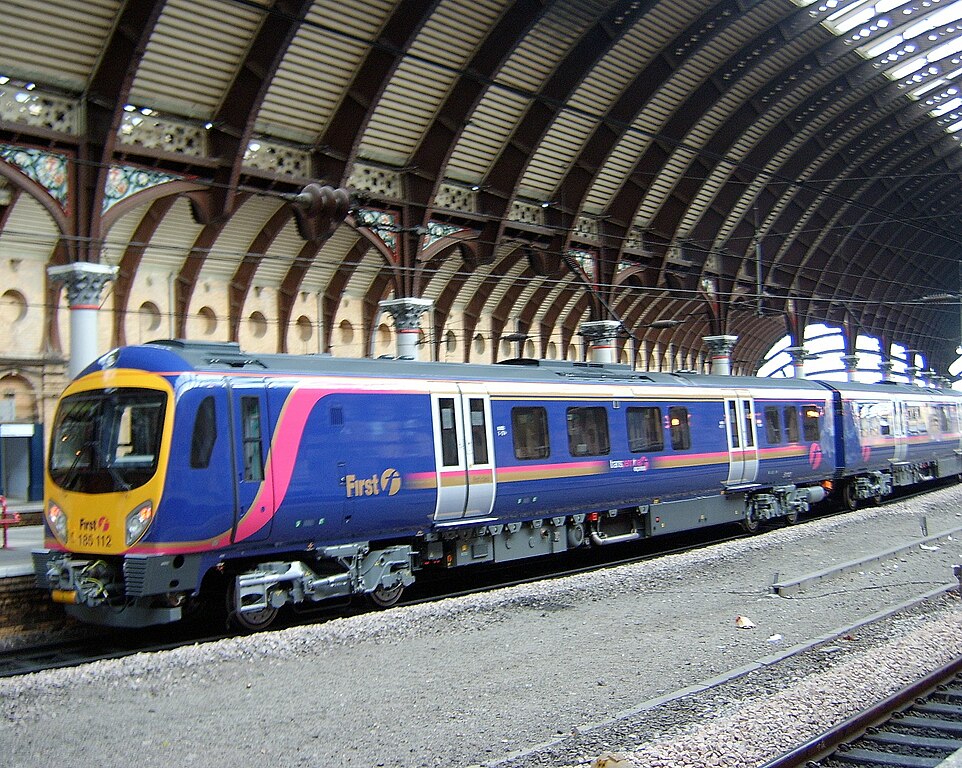
The class 185's first livery known as the Barbie livery, as seen in 2006. This was used during testing only.
See also
Last updated 10 June 2024. All information and images sourced from the relevant Wikipedia article(s) unless stated otherwise. If any information is incorrect, please let us know by emailing us: [email protected]. Text is available under the Creative Commons Attribution-ShareAlike License 4.0; additional terms apply.

